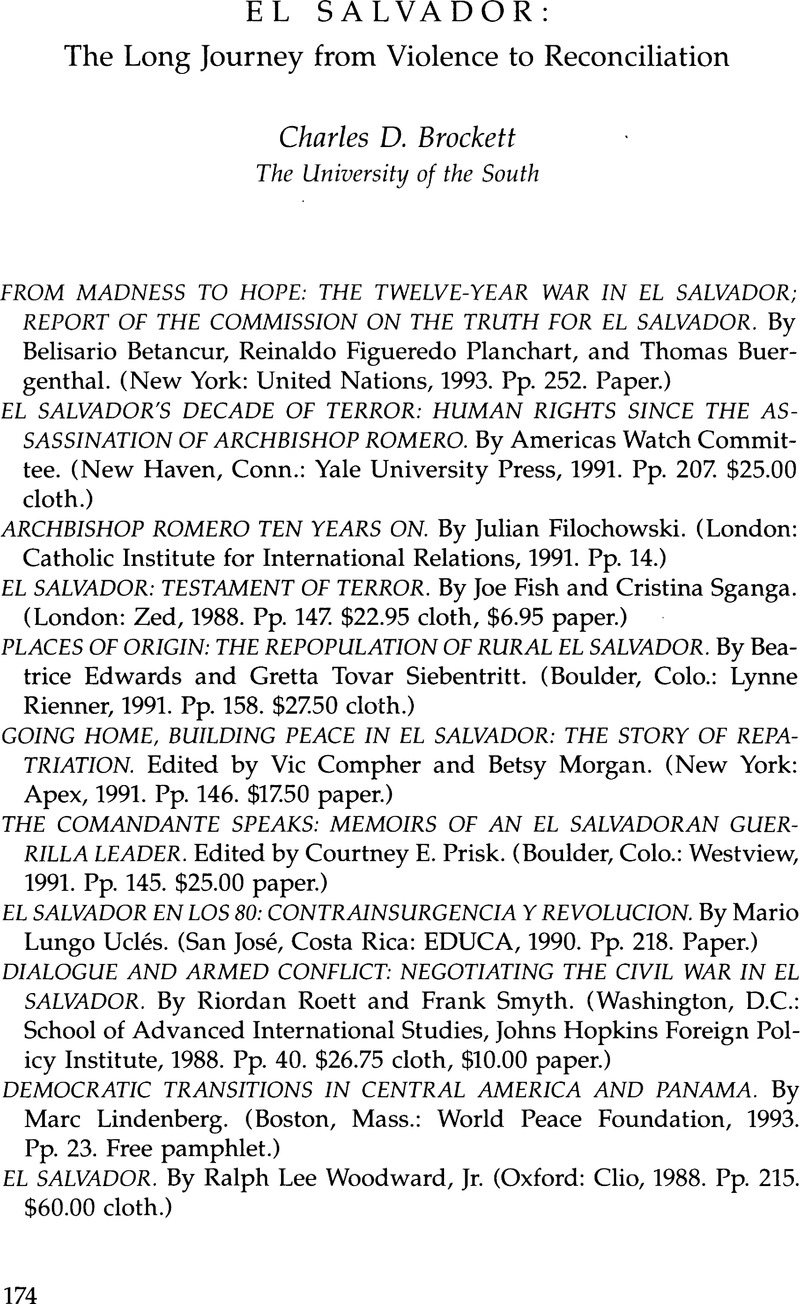Published online by Cambridge University Press: 05 October 2022

1. Nonetheless, two of the works under review here provide succinct but sound syntheses that teachers might find useful for instructional purposes. Ralph Lee Woodward's El Salvador, part of Clio Press's World Bibliographical Series, opens with an excellent ten-page historical summary that begins with indigenous settlement and concludes with the last days of José Napoleón Duarte's presidency in 1988. El Salvador's Decade of Terror also begins with a historical overview, this one focusing on the period following World War II. These sixteen pages cover much territory, not just descriptively but also by way of explanation.
2. The main body of the commission's report is available in both English and Spanish. Nine annexes that provide documentation for the main report were also published, but only in Spanish. They can be consulted in the United Nations' Dag Hammarskjöld Library in New York City.
3. The three members selected were Belisario Betancur, chair and former president of Colombia; Reinaldo Figueredo Planchart, former foreign minister of Venezuela; and Thomas Buergenthal, former president of the Inter-American Court of Human Rights.
4. Both publications also discuss other extrajudicial executions by the FMLN, such as the Zona Rosa killings in 1985. In addition, the Americas Watch volume also examines the use of land mines and forced recruitment by the guerrillas.
5. Filochowski means “saint” literally; both he and the Catholic Institute for International Relations have advocated beatification of Romero.
6. The president of the Supreme Court is cited again for his interference in the investigation of the El Mozote massacre (p. 120).
7. For its first conclusion, the commission found “substantial evidence” (meaning “very solid evidence”); for the second, the evidence was “sufficient” (meaning “more evidence to support the commission's finding than to contradict it”). For details, see p. 24.
8. The reports of the forensic investigation, as well as a photographic report, are available in the first volume of the annexes to the commission's report.
9. Castellanos was assassinated by the FMLN in February 1989 in an act of “revolutionary justice.” The FMLN justified his murder as a legitimate execution of a traitor whose information to the government contributed to repression of the FMLN. The Commission on the Truth for El Salvador's conclusion on this case is concise: “international humanitarian law does not permit the execution of civilians without a proper trial” (p. 163).
10. None of the books and pamphlets included in this review cover the culmination of the Salvadoran peace process. Useful summaries of the key events can be found in essays by Alvaro de Soto (the United Nation's key negotiator for Central America) and by Gary Bland in Is There a Transition to Democracy in El Salvador?, edited by Joseph S. Tulchin (Boulder, Colo.: Lynne Rienner, 1992).
11. Missing is Raymond Bonner's informative Weakness and Deceit: U.S. Policy and El Salvador (New York: Times Books, 1984), while the book of his colleague Tom Buckley receives an unfavorable annotation.
12. David G. Browning, El Salvador: Landscape and Society (London: Oxford University Press, 1971).
13. Thomas P. Anderson, Matanza: El Salvador's Communist Revolt of 1932 (Lincoln: University of Nebraska Press, 1971).
14. William H. Durham, Scarcity and Survival in Central America: Ecological Origins of the Soccer War (Stanford, Calif.: Stanford University Press, 1979).
15. James Dunkerley, The Long War: Dictatorship and Revolution in El Salvador (London: Verso, 1982, 1985).
16. Oscar A. Morales Velado et al., La resistencia no violenta ante los regímenes salvadoreños que han utilizado el terror institucionalizado en el período 1972-1987 (San Salvador: Universidad Centroamericana, 1988).
17. Enrique Baloyra, Salvador in Transition (Chapel Hill: University of North Carolina Press, 1982).